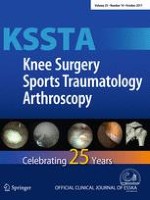01-10-2017 | Knee
Incidence and long-term follow-up of isolated posterior cruciate ligament tears
Published in: Knee Surgery, Sports Traumatology, Arthroscopy | Issue 10/2017
Login to get accessAbstract
Purpose
Isolated posterior cruciate ligament (PCL) tears are an uncommon injury. The goals of this study are to (1) determine the population-based incidence of isolated PCL tears, (2) compare the occurrence of secondary meniscal tears or arthritis in patients with PCL deficiency to patients without PCL tears, and (3) evaluate factors associated with long-term sequelae among patients with PCL deficiency.
Methods
This retrospective study included a population-based incidence cohort of 48 patients with new-onset, isolated PCL tears between 1990 and 2010, as well as an age and sex-matched cohort of individuals without PCL tears. A chart review was performed to collect information related to the initial injury, treatment, and outcomes. Subjects were retrospectively followed to determine the development of subsequent meniscal tears, arthritis, or total knee arthroplasty (TKA).
Results
The age- and sex-adjusted annual incidence of isolated, complete PCL tears was 1.8 (95 % CI 1.3, 2.3) per 100,000. During a mean 12.2-year follow-up, patients with isolated PCL tears had a significantly higher likelihood (HR 6.2, 95 % CI 1.8, 21.2) of symptomatic arthritis compared to individuals without PCL tears. The likelihood of subsequent meniscal tears (HR 2.1, 95 % CI 0.4, 10.7) and TKA (HR 3.2, 95 % CI 0.5, 19.6) was more frequent among patients with PCL tears compared to subjects without PCL tears. Older age at injury was significantly associated with future arthritis (P = 0.003) and TKA (P = 0.02).
Conclusion
Isolated PCL tears remain a rare injury with an estimated annual incidence of 2 per 100,000 persons. Patients with isolated PCL tears have a significantly higher risk of symptomatic arthritis than patients without PCL tears. Older age at injury is associated with a higher risk of arthritis and the need for TKA. The results of this study can be used to educate patients about the natural history of isolated PCL tears and provide a baseline of expectations for the future development of arthritis and subsequent meniscal injury following isolated PCL injury.
Level of evidence
Retrospective comparative study, Level III.





